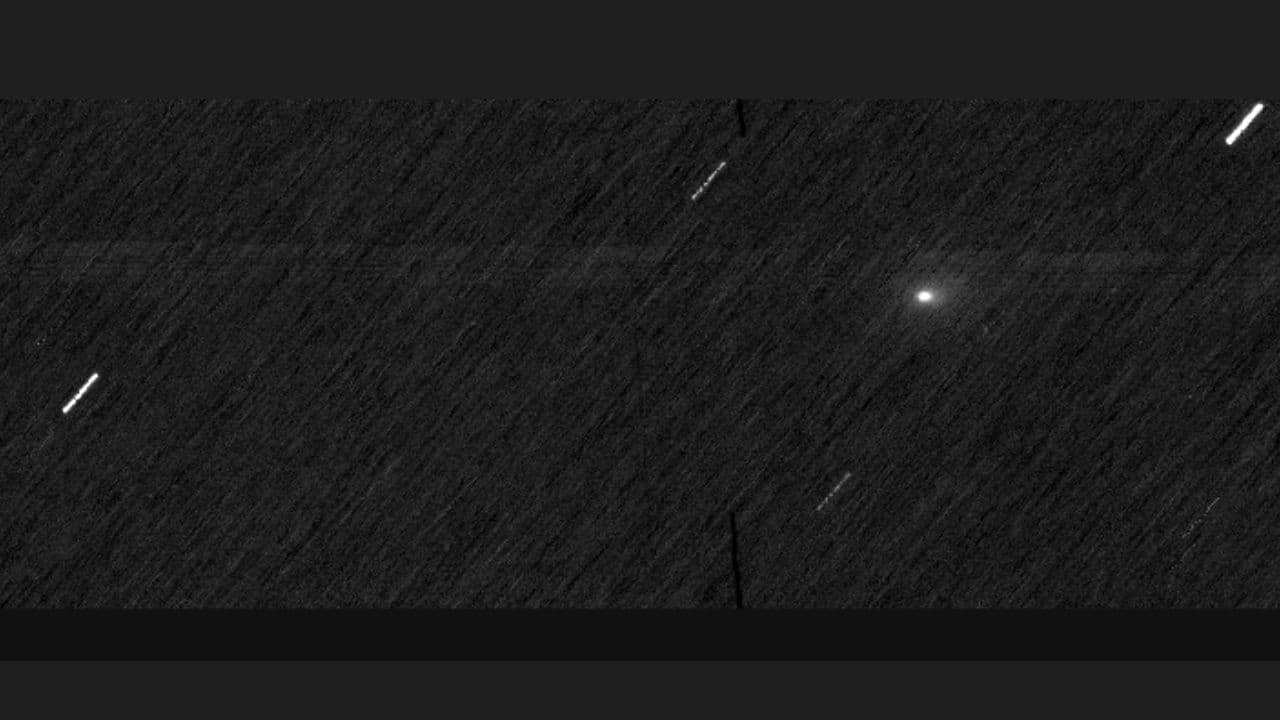
News
October 08, 2025
ESA Mars Orbiters capture rare glimpse of interstellar Comet 3I/ATLAS – See images here
The ExoMars orbiter’s Colour and Stereo Surface Imaging System captured faint images of the comet’s coma, the glowing cloud of gas and dust surrounding its icy nucleus.
**ESA Mars Orbiters capture rare glimpse of interstellar Comet 3I/ATLAS – See images here**
Scientists have achieved a remarkable feat, capturing images of the interstellar comet 3I/ATLAS from an unprecedented vantage point: Mars. The European Space Agency's (ESA) ExoMars Trace Gas Orbiter, currently circling the Red Planet, has successfully photographed the faint glow of the comet, offering a unique perspective on this celestial wanderer.
The images, obtained using the orbiter’s Colour and Stereo Surface Imaging System (CaSSIS), show the comet's coma. The coma is the hazy, cloud-like atmosphere surrounding the comet's icy nucleus. It's formed as the comet approaches the Sun, causing its ice to vaporize and release gas and dust into space.
Comet 3I/ATLAS is an interstellar object, meaning it originated from outside our solar system. These rare visitors provide valuable insights into the composition and conditions of other star systems. Studying them can help scientists understand how planetary systems, including our own, are formed and evolve.
The opportunity to observe 3I/ATLAS from Mars offers several advantages. The ExoMars orbiter is far from Earth's atmospheric interference, providing a clearer view of the comet's faint light. Furthermore, its position in space allows for observing the comet from a different angle compared to ground-based telescopes, potentially revealing new details about its structure and behavior.
The CaSSIS instrument is designed to map the surface of Mars in color and 3D. Its capabilities extend beyond planetary imaging, as demonstrated by this successful observation of Comet 3I/ATLAS. The images, while faint, are a testament to the sensitivity of the instrument and the ingenuity of the scientists involved.
While the images might not be as visually stunning as some other comet pictures, their scientific value is immense. They provide valuable data that can be used to study the composition of the comet's coma, its rate of gas and dust production, and its overall interaction with the solar wind. These observations contribute to a broader understanding of interstellar objects and their role in the galactic ecosystem. The ESA team is continuing to analyze the data collected, hoping to unlock further secrets held within the faint glow of Comet 3I/ATLAS.
Scientists have achieved a remarkable feat, capturing images of the interstellar comet 3I/ATLAS from an unprecedented vantage point: Mars. The European Space Agency's (ESA) ExoMars Trace Gas Orbiter, currently circling the Red Planet, has successfully photographed the faint glow of the comet, offering a unique perspective on this celestial wanderer.
The images, obtained using the orbiter’s Colour and Stereo Surface Imaging System (CaSSIS), show the comet's coma. The coma is the hazy, cloud-like atmosphere surrounding the comet's icy nucleus. It's formed as the comet approaches the Sun, causing its ice to vaporize and release gas and dust into space.
Comet 3I/ATLAS is an interstellar object, meaning it originated from outside our solar system. These rare visitors provide valuable insights into the composition and conditions of other star systems. Studying them can help scientists understand how planetary systems, including our own, are formed and evolve.
The opportunity to observe 3I/ATLAS from Mars offers several advantages. The ExoMars orbiter is far from Earth's atmospheric interference, providing a clearer view of the comet's faint light. Furthermore, its position in space allows for observing the comet from a different angle compared to ground-based telescopes, potentially revealing new details about its structure and behavior.
The CaSSIS instrument is designed to map the surface of Mars in color and 3D. Its capabilities extend beyond planetary imaging, as demonstrated by this successful observation of Comet 3I/ATLAS. The images, while faint, are a testament to the sensitivity of the instrument and the ingenuity of the scientists involved.
While the images might not be as visually stunning as some other comet pictures, their scientific value is immense. They provide valuable data that can be used to study the composition of the comet's coma, its rate of gas and dust production, and its overall interaction with the solar wind. These observations contribute to a broader understanding of interstellar objects and their role in the galactic ecosystem. The ESA team is continuing to analyze the data collected, hoping to unlock further secrets held within the faint glow of Comet 3I/ATLAS.
Category:
Technology